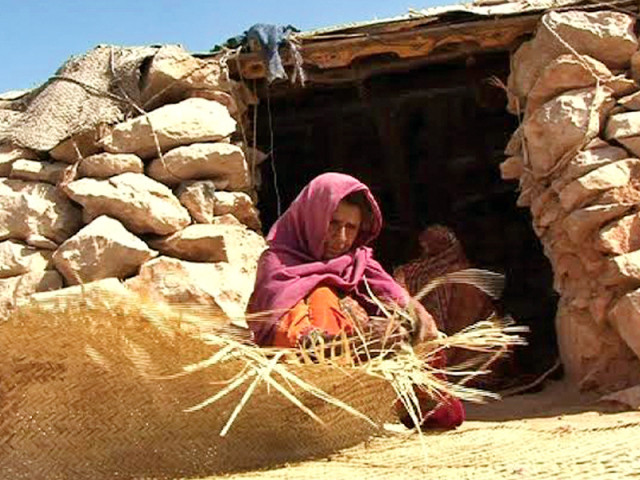From Karachi to Gorakh: Few are the wants of Gorakh, a colouring agent fulfils many
The people only want their water bags, their smokes and the Kahoo plant.

Women make plaited rugs called chatai and take it 56 kilometres down the hill to the Wahi Pandi, where they are sold in markets. DESIGN: MUNIRA ABBAS
Up in the mountains of the Kirthar Range, the people of Gorakh still seemingly live in the stone-age and here, only the fittest survive.
With resources at a minimum, the people live a simple lifestyle. They eat only milk and roti [bread] and sleep in mud-houses. Their wants are limited and something as simple as a plant used as a colouring agent is enough to make them content.
A job for women
Even though some of the men in the village have salaried government jobs, the women make plaited rugs called chatai and take it 56 kilometres down the hill to the Wahi Pandi, where they are sold in markets.
The plant of Peesh is found in abundance at Gorakh, in the wilderness of the Kirthar Range, and it is used to make the chatai. While the rest of the province makes its chatai using the wheat plant, the people of Gorakh prefer the Peesh.
The women soak it in water for a few days in order to make its leaves softer, otherwise the sharp edges can cut through skin. The base of the rug is made with a rope, painstakingly intertwined by hand into the leaves. They are then either fashioned into prayer mats or a tumbri [used to store roti].
The plant of Kahoo is then used to add colour to the chatai. The colour is added to the leaves of Peesh before it is kept out in the sun to dry. However, that is not its only use.
Kahoo
At times, the Kahoo plant is also used to add colour to plain milk when there is no tea; a rare commodity up here in the hills. “It adds almost no taste to the milk and only makes it a little sour,” said a resident of the village, Mama Faizu. “We add the plant just so that we can pretend that we are having tea,” he said with a smile.
Just like Peesh, the Kahoo plant also needs to be processed. It is first cut into smaller pieces and then it is boiled; the longer it is boiled, the darker the colour that it gives. The colour can range from a deep red to dark brown and sometimes, when it is boiled for an especially long time, even black.
Mashkeeza
Mashkeeza [water bag] has long been a basic survival item for people living in mountains or deserts. “We gift our handmade water bags to the travellers because we know the importance of water,” said Faizu. “How can we use these bags for business? Only we know the value of water because we know how it feels to survive without it,” he added, his face suddenly grave. “You have no idea how important water is and I pray that you never find out.”
The water bag is made out of goat skin. The goat is skinned sand hung out on a tree to dry. Even here, the people manage to find a use for Kahoo. The dried skin is soaked and washed with Kahoo leaves to get rid of the smell and to add colour to it. The charbi [fat] is also removed. After that, it is dried again and then sewed back to shape it into a bag.
The hide is then burned until all the hair falls off. The bag is dried again for two days. If any odour still remains, the bag is washed and dried again. The bags last at least a year without showing any signs of wear and tear and if used with care, they can function for up to five years.
Published in The Express Tribune, April 27th, 2014.


















COMMENTS
Comments are moderated and generally will be posted if they are on-topic and not abusive.
For more information, please see our Comments FAQ